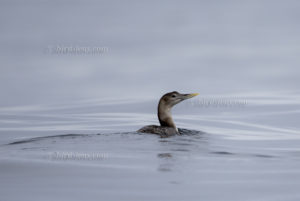 A dam in the middle of the Sauerland in Germany in hazy weather with low-lying clouds combined with drizzle, wind from the west with in gusts 4 bofors at 8 ° Celsius normally is not the place to stay and watch. But this is the place to add a vagrant Yellow-billed Loons or White-billed Divers (Gavia adamsii) on the german birdlist. Yellow-billed Loons are highly thought-after species for the serious birdwatcher of continental Europe. And it is a big event, if a Yellow-billed Loon is observed so far inland in Europe.
A dam in the middle of the Sauerland in Germany in hazy weather with low-lying clouds combined with drizzle, wind from the west with in gusts 4 bofors at 8 ° Celsius normally is not the place to stay and watch. But this is the place to add a vagrant Yellow-billed Loons or White-billed Divers (Gavia adamsii) on the german birdlist. Yellow-billed Loons are highly thought-after species for the serious birdwatcher of continental Europe. And it is a big event, if a Yellow-billed Loon is observed so far inland in Europe.
Starting form December 13th of 2016 a juvenile Yellow-billed Loon was detected on the Diemelsee near Kotthausen. Striking were the yellowish and upward shifted massive beak, with a striking angled lower mandible. In addition to the brownish-washed body and the light head, the dark washed ear spot and the bright neck back were striking. For the next 2 weeks, the bird obviously loved the seaside resort at the height of the lido, from which a bunch of birder could observe the diver very well. Yellow-billed Loon mainly was constantly moving from west to east – maybe due to the winddrift from west. Then it flew back to the west to drift east. In between, extensive diving phases, then resting phases, were observed. Often the head was hold under water – to search for food. Despite an injury, the Gavia adamsii is apparently in good shape. Extensive dives of approx.100m were not rare. Sometimes it shows a terrestrial type of intense plastering with ‘watering’ wings, a short submerge as well as breathtaking neck dislocations.
The last time, a Yellow-billed Loon was observed in the middle of Germany, was near the small city of Goerlitz in the southeast corner of Saxony/ Germany. The bird could be seen for well 2 month on a lignite mining lake, called Berzdorfer See (lake). The distance to the next bigger water body, which you can call a sea, is roughly 400km away.
After having successfully seen and photographed a Yellow-billed Loon on its “right” winter habitat on the west coast of Norway, at the edge of the Barents Sea and along the shores of the Bering Sea, I did not hurry-up to travel to the Sauerland.
In Germany, most observations are made on the Northern Sea and the Baltic Sea as well as on the Bodensee. The Yellow-billed Loon (Gavia adamsii) belongs to the family of loons – or divers as they are called, too. In Europe, you can see the Yellow-billed Loon mainly as a winter visitor to the coast of northern Norway. The Yellow-billed Loon might also be observed during visits to Varangerfjord at the edge of the Barents Sea. The breeding areas are but clearly further east; to Russia and Alaska coasts.
To cope with the growing demand for top shots of the rarer species of the Palearctic Bird-Lens is keen to enrich the range of pictures of birds you can find in the western palearctic. Beside the image above you can find a nice selection of birds in the gallery or in the “Pictures Shop” very soon. Just give a message, if Bird-Lens could serve you with an image needed before the new pictures are online.